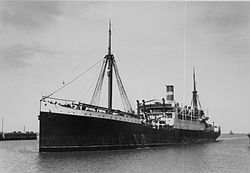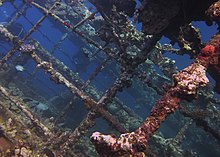Umbria (ship)
|
as the Argentine van Bahía Blanca
|
||||||||||||||||||||||
|
||||||||||||||||||||||
|
||||||||||||||||||||||
|
||||||||||||||||||||||
|
||||||||||||||||||||||
The Umbria is a shipwreck in the Red Sea off Port Sudan . The Italian freighter with a load of ammunition was sunk there by its Italian crew in 1940 when war broke out between Italy and Great Britain.
The ship was completed in Hamburg in 1912 as Bahía Blanca for Hamburg Süd . It was used to transport emigrants and seasonal workers to South America. During the First World War , the ship was laid up in the port of Puerto Madryn .
In 1918 it was sold to the Argentine government and served as a transport in the Argentine Navy until 1934 . Actually sold to Italy for demolition, the ship was turned into a troop transport by the Italian government in 1935 because of the Abyssinian War and renamed Umbria .
History of construction and use
The Bahía Blanca was the type ship of the four large emigrant ships that were built for the Hamburg-Süd from 1911 by the Reiherstieg shipyard ( Bahía Blanca , Bahia Castillo ) and the Bremer Vulkan ( Buenos Aires , Bahia Laura ). The two-masted ships could transport over 2,000 emigrants or seasonal workers and were used between Hamburg and Buenos Aires.
The Bahía Blanca , built under construction number 444, was launched on December 30, 1911 and began its maiden voyage to South America on March 14, 1912. It offered space for 108 passengers in a second class and 2,300 between deck passengers. In 1913 the deckhouse was increased as in the last two newbuildings in order to double the number of passengers in the second class. In 1914, after the outbreak of war , the Bahía Blanca called at the port of Puerto Madryn and was launched for the duration of the war. On April 16, 1918, it was sold to the Argentine government.
In Argentine service
The ship served as the transporter Bahía Blanca in the Argentine Navy until 1934. The English did not initially acknowledge the sale, so the ship's first voyage was to Philadelphia in 1920 to fetch coal for the Argentine fleet, which was in great shortage in Argentina as there was a great need among the belligerents during World War I. Powers existed and Argentina was largely excluded from a supply because of its neutrality. On this voyage, it also seems to have called into New York , where 20 Argentinians disembarked. In 1921 the ship drove to Hamburg with Argentinian groceries and returned via the USA to fetch coal again. In 1924 she was able to fetch coal from Cardiff for the first time on two trips , with agricultural products being loaded again on the way out. Two similar trips to Birkenhead followed in 1925 . In addition to these trips to Europe until 1931, the Bahía Blanca also made regular trips to the southern region of Argentina since 1923 to supply the bases there. In 1929 she visited her old home port of Hamburg again when severe drive problems arose on a trip to Europe and the shipyard carried out the necessary repairs on the machine. On this voyage, she had the transfer crews on board for the three Mendoza- class destroyers built at White in Cowes .
Her last trip to Europe in 1931 took her first to Italy with the crews for the transfer of the cruisers Almirante Brown and Veinticinco de Mayo, which were built there, and then to Cardiff, from where she returned to Argentina with a load of coal.
From 1932 the ship was disarmed and decommissioned on November 22, 1934. The ship was then publicly auctioned. The buyer in 1935 was the company "Enrico Haupt" in Genoa , which supposedly wanted to scrap the ship. The Bahía Blanca was transported to Italy in tow .
In Italian service
In view of the Abyssinian War, however, the ship was prepared as a troop transport in Italy, renamed Umbria and used to transport troops and to supply the Italian troops in East Africa. After the end of the war, the ship was made available to the Italian state shipping company Società Italia for liner service at Lloyd Triestino .
The sinking of the Umbria
The Italian Navy ship sank shortly after Italy entered the Second World War . In June 1940 the Umbria had driven 6,000 tons of bombs, 60 boxes of detonators, explosives, weapons and three Fiat 1100 Lunga from Genoa via Livorno and Naples into the Suez Canal and on its way via Massaua and Assab to Calcutta . However, she came under the control of the Royal Navy at Port Said on June 3, 1940 and was detained for three days. She was then pursued by British boats and intercepted on June 9 at Port Sudan by the sloop Grimsby and the light cruiser Leander . The British forced the Italian captain to moor at Wingate Reef as they were informed of Italy's imminent entry into the war and also of the cargo on board the Umbria .
On the evening of June 10th, Captain Lorenzo Muiesan learned by radio that Italy had entered the war. Together with his marine engineer Costa and the first officer Zarli, he decided to sink the Umbria . In order not to endanger the crew, he spoke to the British officer Stevens and asked for permission to conduct a rescue exercise with his crew. Stevens, who was not yet aware of Italy's entry into the war, allowed this. Shortly afterwards, he was informed that water had entered the holds. Stevens was still able to get his people off board, but could no longer prevent the ship from sinking, which occurred within two hours.
The Umbria as a diving destination
The wreck is tilted to the side at 19 ° 38 ′ 12.2 ″ N , 37 ° 17 ′ 25.6 ″ E. in maximum 36 meters deep in Sudanese waters, easily accessible from Bur Sudan. The starboard side is directly below the surface of the water, the davits of the lifeboats protrude beyond this.
The sheltered location - the Wingate reef protects against currents and tidal fluctuations - enabled the Umbria to transform itself into a diving paradise over the decades: various sponges, fish and other sea creatures gradually took possession of the wreck. Hans Hass was able to document the different stages of development . Today, almost all of the wreck, including the cargo and deep decks, has different forms of life.
literature
- Holger Göbel, Ralf Bergemann: Diving travel guide Sudan . Delius Klasing, Bielefeld 2000, ISBN 3-89594-077-1 , p. 93 to 99 .
- Massimo Bicciato, Umbria , in: Egidio Trainito (ed.), Adventure wreck diving. On the trail of sunken worlds , White Star Verlag, Wiesbaden 2009, ISBN 978-3-86726-120-3 , pp. 178-185
- Arnold Kludas: The ships of Hamburg-Süd 1871-1951 , Verlag Gerhard Stalling, Oldenburg / Hamburg 1976, ISBN 3-7979-1875-5 .
- Arnold Kludas : The History of German Passenger Shipping. Volume 3: Rapid growth 1900 to 1914. Ernst Kabel Verlag, Hamburg 1988, ISBN 3-8225-0039-9 ( writings of the German Maritime Museum 20).
- Claus Rothe: German ocean passenger ships 1896 to 1918 . Steiger Verlag, 1986, ISBN 3-921564-80-8 .
Web links
- English page scubatravel.co.uk with pictures
- Italian side for the sinking of Umbria
- Another Italian side about the sinking of Umbria
- Dates and history of the Bahía Blanca on histarmar.com.ar (Spanish)
Footnotes
- ↑ a b Mar Rosso: il relitto "Umbria" , on appuntidiviaggio.info ( Memento from August 17, 2011 in the Internet Archive )
- ↑ a b scubatravel.co.uk
- ↑ Kludas: The History of German Passenger Shipping , Volume III, p. 45.
- ↑ a b c d e Kludas: The ships of Hamburg-Süd 1871-1951 , p. 80.
- ↑ Arrival of the Bahía Blanca on May 6, 1920 ( Memento of November 12, 2013 in the Internet Archive ) on Ellis Island.
- ↑ a b wannadive.net
- ↑ nordico.at
- ↑ polarfilm.de ( Memento from October 26, 2007 in the Internet Archive )

